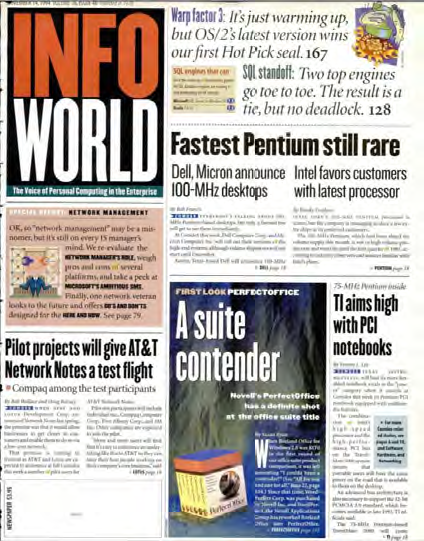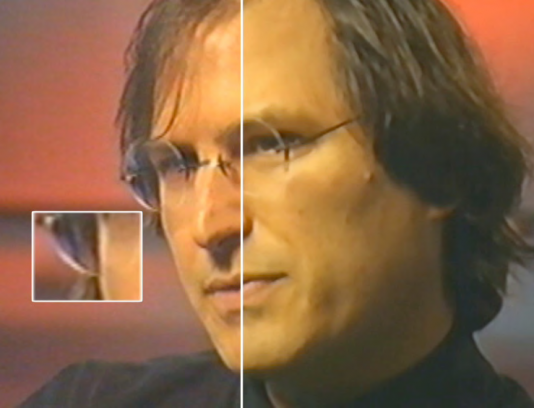The lost interview from 1995 was recorded in low-resolution VHS, and restored by state-of-the-art technology from MotionDSP.
By Jon Peddie
Back before the Internet bubble went popadoodle, there was a great tech tabloid-style newspaper, InfoWorld. The journal survives today as a webzine and is indistinguishable from the two dozen others delivering the same stories. But then, it was the bible, it was edgy with columns from Stewart Alsop, Brian Livingston, John Gantz, Bob Metcalfe, Brooke Crothers, Cate Corcoran, and one Robert X. Cringely (aka I. Cringely), the pen name of Mark Stephens, a Stanford graduate who was Apple employee #12.

In 1995 Stephens/Cringely left InfoWorld and won a lawsuit allowing him to continue to use the pen name. As Cringely he did a series of video-taped interviews with Steve Jobs. A few clips were included in Triumph of the Nerds (TOTN), a documentary released in 1996. If you’ve ever seen the 1995 interview with Steve, it’s famous for his trashing of Microsoft. The interview was shot at NeXT headquarters in Redwood City, California; NeXT was Jobs’ startup after he was fired at Apple.
Cringely had planned to use the interviews in another documentary about the internet, but the master tapes for TOTN—all of them—were somehow lost while being shipped from London to Portland, Oregon, for that second series. The Steve Jobs interview was gone forever. After Jobs’ death in October 2011, TOTN director Paul Sen started aggressively looking for the tapes and found a VHS copy of the Jobs interview stored in his UK garage. “This,” says Cringely “is undoubtedly the only surviving copy of the best TV interview Steve Jobs ever gave yet nobody ever saw. As Cringely would later describe it: “This interview is a moment in time. NeXT was in trouble in 1995, though Steve would never admit it. Apple, too, was at a low point. And none of us could know that NeXT would be sold to Apple within a year and Steve would be back.”
The master was a VHS tape, and by today’s standards and taste, it “looked crappy.” To quote Cringely, “We had only used nine of the 69 minutes for our show back in 1995, and everyone recalled that the interview had gone extremely well. Watching it again after 16 years it was, well, astonishing. But it was also terrible video—a low-resolution PAL VHS dub that had suffered for all those years in the garage.
“Still, we threw the best technology we could find at the job of fixing the video and blowing it up for the big screen. A major post-production house in the UK undertook the job, but there were still many problems, especially strange flashing artifacts that we were never able to remove.”
Saving the day
Looking for some magic, Cringely searched the web and found MotionDSP’s $49 Windows-only software vReveal; but the results were unsatisfactory. He discovered that the company had a product available that cost more than $25,000; thinking software that expensive must be capable of anything, Cringely took a shot. “That software didn’t work, either,” he said sadly. “It turns out that there’s a huge difference between terrain and an enormous Steve Jobs face.” Where he got lucky was in developing a relationship with MotionDSP’s engineers.
Cringely contacted Sean Varah, CEO of MotionDSP, and discovered that the company was still working on a filter that would work for the job. The team used a pre-release version on the Jobs interview, which did the trick. Varah is quick to tell you that the filter is now included with MotionDSP’s high-end Ikena range of products.

Cringely said that he got a lot of help from MotionDSP in the process of putting his film together for Magnolia Pictures. “I asked MotionDSP to use their Ikena software to fix the video and enhance its resolution. They did far more than I asked. They completely rebuilt the film, frame by frame, removing the jaggies, enhancing the resolution, restoring the color, eliminating those strange flashes, while turning a 352-by-288 PAL VHS frame back into the 720-by-576 frame in which the video was originally shot. It was a simple job from there to upscale the film to Blu-ray for distribution. MotionDSP rebuilt our movie. We wouldn’t have done it without them. I know that because we tried.
“The hardest artifacts for us to fix were those random flashes, which apparently covered several frames each. We tried other super-resolution products, but none of the others look at more than 10 frames at a time while Ikena looks at up to 100 frames, eliminating the problem.”
The Steve Jobs interview suffered from video noise, interlacing artifacts, and poor color and lighting. Varah describes it as tricky. “To deal with the video noise,” said Varah, “our super-resolution algorithm reconstructs each frame of video with the most statistically valid information, reconstructing and restoring the video without noise. De-interlacing is problematic where you have fine details such as Steve Jobs’ glasses in the foreground, and other objects in the background. Our special de-interlacing avoids ‘the jaggies’ in all parts of the image—both foreground and background. And as for poor color/lighting, we adjusted the lighting with our auto-white balance and contrast filters, and adjusted the unnatural red tint.”
Varah sent us two 100-MB files, before and after, so we could see the differences—it is impressive. We clipped an image from each to show the difference.
Our take
We’ve written before about MotionDSP, or at least we’ve tried to, they do so much secret work they won’t let us write too much about them. Their software really exploits the GPU, and Nvidia was the first to recognize that. Since then AMD has had it ported to their GPUs as well. It is all Windows based now, but Varah is seriously looking at Android and Mac iOS. The concepts (if not the exact IP) of MotionDSP’s shake removal can be found in popular video editing software from CyberLink, Adobe, and Corel.
The Cringely DVD won’t ship until October, but it is ready for preorder right now on Amazon.com.
[Editor’s Note: GraphicSpeak and Jon Peddie Research TechWatch aren’t the only publications to write about MotionDSP’s great work on the Jobs interview; check out this article from MacLife.]





